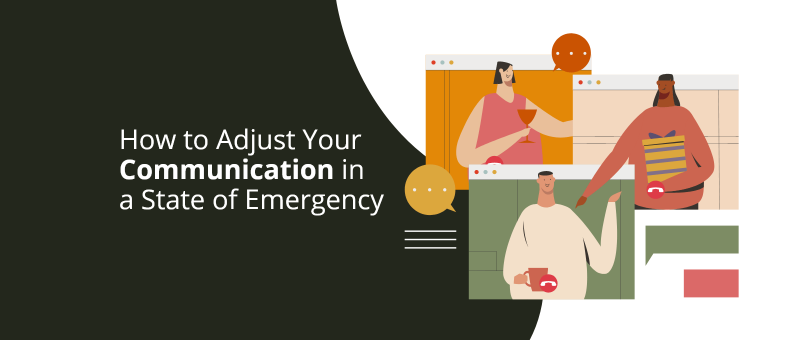Times are tough! The COVID-19 outbreak has affected countless individuals and companies in a multitude of ways. Employees and consumers alike have become anxious as health concerns and economic uncertainties altered worldwide priorities in a matter of days.
Crisis have happened in different forms before, and each of them had a ripple effect on companies worldwide. Remember the 2008 worldwide recession, when the stock market plummeted $8 trillion in value in less than two years? Not to even mention the number of people that lost their homes and their jobs. Or, if you’re old enough to remember, the 2000-2001 Dot com bubble burst, when “overnight successes” literally vanished, well, overnight along with trillions of dollars in losses.
Today, the COVID-19 crisis remains an invisible enemy that we must face. In these types of situations, communication and understanding are of pivotal value. Businesses, employees, and clients must adapt to the situation and its effects, and like always, the strongest ones will prevail.
Now, more than ever, companies must alleviate the operations to the current conditions. This is where a comprehensive communication plan steps in as a cornerstone of stability!
Nobody can act as if nothing happened. Your employees and your clients need you! That is why in times like these, to help one another, we’ve decided to write a guide on how to adjust your communication in a state of emergency and help you maintain your business operations during the crisis.
Assess the State of Emergency

Making the right assessment for the state of emergency can help you better prepare your crisis communication plan
When an emergency unravels, the most important thing is not to overreact without information. The anxiety can only rise if people don’t receive the right information, in the right tone, and at the right time.
Make sure that you get your information from the WHO (World Health Organization) and your industry’s leading organizations. Don’t forget that information travels fast nowadays, and not everything that you’ll hear or see is correct. “Fake news” is a worldwide issue, and that includes news about public health as well.
When it comes to the current pandemic, you should only seek information and advice from medical officials, epidemiologists, the WHO, and your Government’s Department of Health. Read WHO’s daily bulletin and their Q&A, where you’ll find more info about the virus.
After you get the facts right, you can start to assess the severity and how you’ll communicate them to your staff and customers. Make a thorough analysis of how the current crisis will affect your operations, clients, employees, and the industry. Ask yourself and your core team what can be prevented, how you can optimize the teamwork, and what types of responses you’ll provide.
The evaluation will help you create a communication strategy according to your company goals and operational components.
Lots of people are not prepared for states of emergencies. But, at these times, the right words can reassure people, help them adapt much easily, and learn something from the entire experience. Now, more than ever, a company can be the voice of hope and the leadership for everyone involved.
Think about the company’s long-term objectives and stay resilient throughout the crisis. Start with your employees. Tell them that you’ll all stay safe, and you’ll figure things out. More importantly, tell them that right now, you all depend on a team effort. Stay honest about things and fortify their loyalty.
Reach out to your clients with a thoughtful message about getting through this together. Don’t forget to update them about any changes to perks, services or priorities.
If you need more information on preparing your business for the current crisis, visit the U.S center for Disease Control’s Guide for Businesses and Employers to Plan and Respond to the Coronavirus crisis.
Delegate Communication Roles

Only the selected people with the right management skills need to have the right to communicate with employees and clients during crisis
After you’re familiar with the gravity of the situation, you need to delegate your communication roles. You’ll need to have key roles within the team, including managers, human resources department, and the legal department as well to consult you.
Determine who will communicate and what will be communicated. Only the CEO and a handful of other people should communicate to employees and clients about how the company is handling the crisis. Together, you will need to create communication protocols before issuing any type of statement or a message.
Bottom line, the crisis communication team must:
- Conduct regular meetings and monitor the situation.
- Be the principal source of information.
- Provide regular updates about the crisis evolvement and its implications.
- Stay transparent and tell only what they know.
- Be brief.
Even more importantly, you need to eliminate any communication obstacle beforehand. Our CEO Mario Peshev has written about the best internal communication and management practices extensively on his blog.
According to him, these are the obstacles that you need to resolve for better workplace communication, in time of crisis or not:
- Too Many Layers: With too many communication layers, every important message will take longer to be delivered. That is not necessarily wrong, but everything should be concise, especially in times of crisis.
- No Technical Background: Problems arise when people don’t have the right technical preparedness.
- Time/Location Differences: In some remote teams, communication and productivity might be more challenging because people are generally not at the office, and with time zones and cultural differences, things can get slow.
- A Communication Agency: When your team needs a much more efficient communication process, in lots of cases, a freelance project manager can do the job much quicker than another layer in the form of a communication agency.
For more tips on remote work and crisis communication, make sure you also tune in to Mario’s recent live Q&A on the topic:
Leveraging Technology In Remote Work And Communication – Q&A https://t.co/jOmdtW6sdz
— Mario Peshev (@no_fear_inc) March 26, 2020
Maintain a Balanced Internal Communication

To balance facts with empathy during a crisis is the best way to communicate with your employees.
Disruptions are inevitable in times of crisis and emergencies. You may need to temporarily interrupt the standard workflow and try to communicate effectively. However, you need to ensure good productivity.
This is why you need to determine the tone of communication, channels, as well as the cadence for meetings and state of emergency discussions.
The most important thing is to remain transparent and fortify the trust that employees have in the company. Remember to stay empathetic as well. At DevriX, communicating with empathy has been key for getting through the crisis, for the team, the community, and our clients.
In 2020, health is above any other priorities, each of your employees has to take care of themselves and their families. We are also aware that a state of emergency often means an economic decline as well. So, even if you need to cut your losses as a team, it needs to be announced in a timely, and emphatic manner. Crises like these are the times when leaders must emerge and show their real capabilities.
The voice of leadership is pivotal in every crisis. Mark Cuban himself said that how you treat your employees now can completely redefine your brand.
Don’t sugarcoat things. State the facts clearly and acknowledge the situation. Make the team understand why some decisions are made. Even a short message or a video directly from the CEO can help, employees like to hear a reassuring voice tell them that everything is going to be fine in the end.
However, remember that at any given stage, communication is a two-way street. Each employee must be given a chance to express his/her opinion, whether through a mutual survey, or a direct one-on-one meeting.
Let people express their concerns. If employees have more questions that can help them understand why certain policies are now in place, make sure that those questions are properly answered. Here’s an excellent communication example by Intel. It establishes company policy and latest updates.
Formulate a Client Communication Plan
Your clients are the backbone of your success as a company. Any diminished communication in times of crisis can mean a loss in profits, and worst, it can harm your business in the process. Clients count on you the most, especially if they’re using your retainer services.
This is why you must remain proactive! Here’s what Salesforce, a cloud-based software business with over 49,000 employees, would advise you to do when communicating with clients during a state of emergency:
- Show That You Care: Send a heartfelt message to your clients that shows you’re fully aware of the crisis, and that you’re ready to help with additional work and resources.
- Remain Proactive: Whatever you have to change your business operations, announce it immediately to your clients. Don’t make them wait and answer any questions they have immediately!
- Use Adequate Channels: Use your email service, social media DMs, and posts, push notifications, chatbots, and alter the homepage of your site if you want to make a message public as well. Use every channel to keep the communication flowing.
- Be a Human Being: We are not robots. We’re humans. Ask how you can help your clients during an emergency. Offer to help them with anything that will keep them safe in their home offices.
- Motivate and Animate: Do everything that you can to inspire your clients! Share every resource with them, donate not only money but your time too. Ask them how you can get involved in their communities and help further their branding these challenging times.
- Review Your Content: Never underestimate the power of content! Do an audit of your blog and social media posts. Don’t allow your content team to create or post something insensitive or non-empathetic.
Gather your content team and package all guides, courses, freebies, and share them with your clients as a way to improve their education and promote new opportunities!
Here’s how HubSpot, one of the most prominent global B2B companies, is responding to the current crisis by supporting their customers and partners:

The worldwide coronavirus crisis affected every company, including your clients. Show them that you care.
- Reducing Prices: Their customers now have access to their tools with a reduced price for an entire year.
- Increasing Limits: HubSpot suspends marketing email sending limits for Marketing Hub Professional and Enterprise clients, and increases the limit for sales calls minutes.
- Offering Free Tools: To help companies adapt to the current situations, HubSpot made the Meetings, Quotes, and E-signature tools free for 90 days for their clients.
- Commission Advances: They’re offering an advance of six months for their Platinum, Diamond, and Elite Solutions Partners.
One of the leading marketing experts in the world, Neil Patel, despite losing several clients due to the worldwide pandemic crisis, allowed more features of his paid SEO tool UberSuggest for free, not just his clients, but for everyone that needs it.
In the end, each message that you send to your clients needs to reassure them that you’re doing all in your power as a company to continue to deliver quality and timely service! Be as genuine, compassionate, and honest as possible with your clients to strengthen and nurture the relationships with them.
Continue to provide resources and answer questions, even beforehand, with an FAQ section or a document. Stay in touch with your business partners, and this too, shall pass!
Handle Public Communication Professionally
What you say publicly on your company channels is just as important as what you say in private to your team and customers.
In moments of worldwide crisis, you can’t market your services like everything is normal. As a brand, you also need to do your best not to be perceived negatively.
Don’t keep profit as a priority! Consumers are looking for guidance, leadership. Now is not the time to strengthen the relationships with your community and followers in your industry.
When it comes to brands’ public communication channels, nothing compares to Twitter nowadays, whether it’s celebrating good times or addressing states of emergencies. Major brands such as Slack are being careful not to be over-promotional, but rather, encouraging and helpful instead.
https://twitter.com/SlackHQ/status/1237860335714885637
Other brands such as Aritzia in response to the COVID-19 crisis have started donation campaigns to show their support for health workers and people affected by the crisis.
With our lead donation of $10 million retail value in Aritzia Community™ Relief Packages, we’re already halfway there. Sponsor a Hero to help us get to $20 million. https://t.co/Iiv8z8VP1S #AritziaHeartsYou pic.twitter.com/kXYCeImm67
— aritzia (@ARITZIA) May 6, 2020
Here’s what Twitter outlined as the most important steps that every company must stick to on their platform in these challenging times:
- Know Yourself: Each brand is unique. Now, you need to look for opportunities to remain helpful and lead by example, which is the only logical thing to do.
To reduce the spread of coronavirus, many teams are turning to remote work. We’re here to help. So if you’re looking for resources on how to transition your team to remote work, here are a few. https://t.co/XlChPRHqq9
— Slack (@SlackHQ) March 4, 2020
- Stay Thoughtful: For years, social media platforms have been the place where quality sarcasm and a joke were good for brands. But, not today! You need to keep things in the right context and stay thoughtful with your public posts. Offer your help, leave humor for better times.
Your pub needs help. Here’s our proposal: Beer for you, double the money for your pub.
Today we launch #SavePubLife. Buy a gift card for your favourite pub, we’ll match the amount and donate the cash now.
Find or nominate your local now: https://t.co/mVRCMHHhJ5 #BrewKindness pic.twitter.com/QPxpBZFSdW
— Budweiser UK (@BudweiserUK) March 27, 2020
- Predict the Changes: When people are in self-isolation mode, it’s evident that their consumer behaviors and habits will change. You need to be aware of these changes and react appropriately.
For the next 2 weeks, there’s no change or cancellation fees* with any of our fares. Applies to bookings made 2/27-3/11 for travel through 6/1/20. Details > https://t.co/Z2MO9WX3Zz pic.twitter.com/tZBI3tL19O
— JetBlue (@JetBlue) February 26, 2020
- Spread Positivity: As humans, we crave positivity. With social distancing measurements and virus precautions in place, positivity is necessary more than ever. As a brand, you need to continue to connect with your audience and celebrate the positive moments.
This International Women’s Day, we are proud to celebrate the women using their creativity for something bigger than themselves. Meet the women making history #BehindtheMac, set to @Beyonce’s anthem ***Flawless. Tap for a thread of their stories. #IWD2020 pic.twitter.com/NsdZ7FHiHW
— Apple (@Apple) March 3, 2020
Wrapping Up
When handling crises and uncertainties, communication is the right way to go. It’s what helps you resolve challenging situations and turns things around.
Furthermore, you might not have control over worldwide health and economic emergencies. But, you do have control over the manner in which you communicate the situation to your employees and clients.
Through empathetic, clear, and constructive communication, you’ll avoid damaging your company’s reputation and increase the trust in your brand over the long run.
We hope that we’ve inspired you on how to better adjust your communication in a state of emergency. As a continuous enterprise partner, we will continue to share resources and get through the crisis together.





